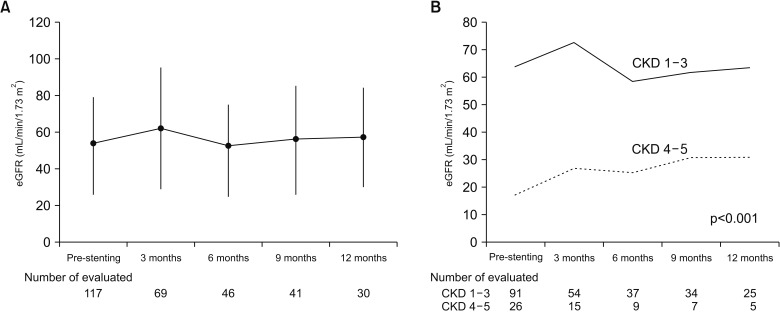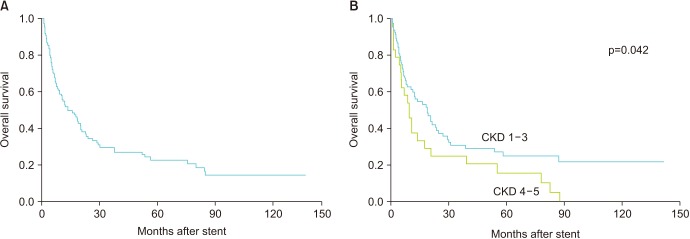Investig Clin Urol.
2018 Nov;59(6):376-382. 10.4111/icu.2018.59.6.376.
Renal function is associated with prognosis in stent-change therapy for malignant ureteral obstruction
- Affiliations
-
- 1Department of Urology, Ulsan University Hospital, University of Ulsan College of Medicine, Ulsan, Korea. tmkwon@uuh.ulsan.kr
- KMID: 2424292
- DOI: http://doi.org/10.4111/icu.2018.59.6.376
Abstract
- PURPOSE
The authors performed this study to investigate the risk factors for predicting stent failure and to evaluate its impact on prognosis.
MATERIALS AND METHODS
Between January 2002 and March 2017, we retrospectively reviewed 117 consecutive patients who underwent retrograde ureteral stenting and exchanging at least once every 3 months for malignant ureteral obstruction. The patients were classified according to their pre-stenting chronic kidney disease (CKD) stage. The factors affecting stent failure were analyzed using a logistic regression model. Overall survival (OS) was estimated, and the prognostic significance of each variable was estimated using Cox proportional-hazards regression modeling.
RESULTS
Before stenting, 91 patients were CKD stages 1-3 and 26 patients were CKD stages 4-5. These two groups differed significantly only in pre-stenting estimated glomerular filtration rate (eGFR), bilateral obstruction, and pre-stenting pyuria. Among the 117 patients, stent failure occurred in 30 patients (25.6%), and there were no differences between the groups. Pre-stenting pyuria and post-stenting complications were significant predictors of stent failure. There were 79 deaths in total, including 56 in the CKD stages 1-3 group and 23 in the CKD stages 4-5 group. In the multivariate analysis predicting patient OS, pre-stenting eGFR and post-stenting disease progression were significant factors.
CONCLUSIONS
Internal ureteral stenting was effective for maintaining renal function in malignant ureteral obstruction. However, it did not restore renal function, which is related to the prognosis of the patients. Therefore, to improve patients' renal function and prognosis, patients who require stenting must be quickly recognized and treated.
Keyword
MeSH Terms
Figure
Reference
-
1. Rosenberg BH, Bianco FJ Jr, Wood DP Jr, Triest JA. Stent-change therapy in advanced malignancies with ureteral obstruction. J Endourol. 2005; 19:63–67. PMID: 15735386.
Article2. Yachia D. Recent advances in ureteral stents. Curr Opin Urol. 2008; 18:241–246. PMID: 18303552.
Article3. Liatsikos EN, Karnabatidis D, Katsanos K, Kallidonis P, Katsakiori P, Kagadis GC, et al. Ureteral metal stents: 10-year experience with malignant ureteral obstruction treatment. J Urol. 2009; 182:2613–2617. PMID: 19836807.
Article4. Hafron J, Ost MC, Tan BJ, Fogarty JD, Hoenig DM, Lee BR, et al. Novel dual-lumen ureteral stents provide better ureteral flow than single ureteral stent in ex vivo porcine kidney model of extrinsic ureteral obstruction. Urology. 2006; 68:911–915. PMID: 17070391.
Article5. Song SH, Pak S, Jeong IG, Kim KS, Park HK, Kim CS, et al. Outcomes of stent-change therapy for bilateral malignancy-related ureteral obstruction. Int Urol Nephrol. 2015; 47:19–24. PMID: 25315466.
Article6. Sountoulides P. Are metal ureteral stents indicated in cases of benign upper urinary tract obstruction? Indian J Urol. 2011; 27:305–306. PMID: 22022050.
Article7. Aravantinos E, Anagnostou T, Karatzas AD, Papakonstantinou W, Samarinas M, Melekos MD. Percutaneous nephrostomy in patients with tumors of advanced stage: treatment dilemmas and impact on clinical course and quality of life. J Endourol. 2007; 21:1297–1302. PMID: 18042018.
Article8. Andriole GL, Bettmann MA, Garnick MB, Richie JP. Indwelling double-J ureteral stents for temporary and permanent urinary drainage: experience with 87 patients. J Urol. 1984; 131:239–241. PMID: 6699952.9. Chung SY, Stein RJ, Landsittel D, Davies BJ, Cuellar DC, Hrebinko RL, et al. 15-year experience with the management of extrinsic ureteral obstruction with indwelling ureteral stents. J Urol. 2004; 172:592–595. PMID: 15247739.
Article10. Hyppolite JC, Daniels ID, Friedman EA. Obstructive uropathy in gynecologic malignancy. Detrimental effect of intraureteral stent placement and value of percutaneous nephrostomy. ASAIO J. 1995; 41:M318–M323. PMID: 8573816.11. Levey AS, Bosch JP, Lewis JB, Greene T, Rogers N, Roth D. A more accurate method to estimate glomerular filtration rate from serum creatinine: a new prediction equation. Modification of diet in renal disease study group. Ann Intern Med. 1999; 130:461–470. PMID: 10075613.12. Russo P. Ureteral obstruction and stents: still a difficult problem for patients and urologists alike. J Urol. 2005; 174:2088. PMID: 16280733.
Article13. Ganatra AM, Loughlin KR. The management of malignant ureteral obstruction treated with ureteral stents. J Urol. 2005; 174:2125–2128. PMID: 16280741.
Article14. Yu SH, Ryu JG, Jeong SH, Hwang EC, Jang WS, Hwang IS, et al. Predicting factors for stent failure-free survival in patients with a malignant ureteral obstruction managed with ureteral stents. Korean J Urol. 2013; 54:316–321. PMID: 23700497.
Article15. Wolf JS Jr. 15-year experience with the management of extrinsic ureteral obstruction with indwelling ureteral stents. Int Braz J Urol. 2004; 30:340–341. PMID: 15679976.16. Harrington KJ, Pandha HS, Kelly SA, Lambert HE, Jackson JE, Waxman J. Palliation of obstructive nephropathy due to malignancy. Br J Urol. 1995; 76:101–107. PMID: 7544201.
Article
- Full Text Links
- Actions
-
Cited
- CITED
-
- Close
- Share
- Similar articles
-
- Recent Advances in Ureteral Stents
- Bilateral Ureteral Obstruction Related to Pelvic Rhabdomyosarcoma Presenting with Acute Kidney Injury: A Case Report
- Adverse Effects of Ureteral Stent and Development of the Antireflux Ureteral Stent
- Percutaneous ureteral stent insertion
- Management of 24 Lower Ureteral Obstruction -Especially Internal Stent Indwelling-



